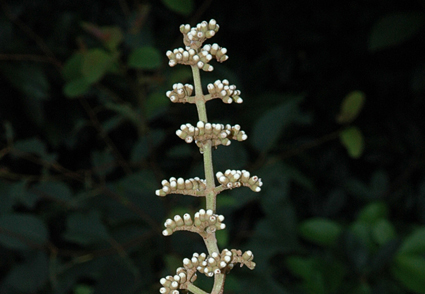Abstract
We describe Miconia leonorae, a new species exclusive to eastern Brazil, mainly from the evergreen forests of the Atlantic Forest Domain. This species can be distinguished from a wider circumscription of Miconia lepidota. It is classified as Miconia supersect. Discolores sect. Multispicatae and can be distinguished from similar species by features such as an acute leaf base and apex, light brown to gray abaxial leaf blade indumentum with lepidote-stellate trichomes (becoming glabrescent on mature leaves), cylindrical, scorpioid inflorescences with basal branches only bifid or trifid, and an androecium with isomorphic stamens.
References
- Bachman, S., Moat, J., Hill, A., De La Torre, J. & Scott, B. (2011) Supporting Red List threat assessments with GeoCAT: geospatial conservation assessment tool. ZooKeys 150: 117–126. https://doi.org/10.3897/zookeys.150.2109
- Berry, P.E. (2001) Miconia. In: Steyermark, J.A., Berry, P.E., Yatskievich, K. & Holst, B.K. (Ed.) Flora of the Venezuelan Guayana 6. St. Louis: Missouri Botanical Garden Press. 82 pp.
- Bickford, D., Lohman, D.J., Sodhi, N.S., Ng, P.K.L., Meier, R., Winker, K., Ingram, K.K. & Das, I. (2007) Cryptic species as a window on diversity and conservation. Trends in Ecology & Evolution 22: 148–155. https://doi.org/10.1016/j.tree.2006.11.004
- Caddah, M.K. & Meirelles, J. (2018) Miconia goldenbergiana (Melastomataceae, Miconieae): a new species from the Atlantic Forest, Brazil. Phytotaxa 356: 167–173. https://doi.org/10.11646/phytotaxa.356.2.6
- Caddah, M.K., Meirelles, J., Nery, E.K., Lima, D.F., Nicolas, A.N., Michelangeli, F.A. & Goldenberg, R. (2022) Beneath a hairy problem: Phylogeny, morphology, and biogeography circumscribe the new Miconia supersection Discolores (Melastomataceae: Miconieae). Molecular Phylogenetics and Evolution 171: 107461. https://doi.org/10.1016/j.ympev.2022.107461
- Candolle, A.P. de (1828) Prodromus Systematis Naturalis Regni Vegetabilis 3: 1–493. [https://www.biodiversitylibrary.org/page/152982]
- Casaretto, G. (1845) Novarum Stirpium Brasiliensium Decades. Joannis Ferrandi, Genuae, 96 pp.
- Chagas, E.C.O, Barbosa, M.R.V. & Goldenberg, R. (2013) A new species of Miconia (Melastomataceae, Miconieae) from northeastern Brazil. Brittonia 65: 305–309. https://doi.org/10.1007/s12228-012-9287-4
- Cogniaux, A. (1887) Melastomataceae. In: Martius, C.F.P., Eichler, A.G. & Urban, I. (Eds.) Flora Brasiliensis. Vol. 14, part 4. C. Monachii, Lipsiae. 626 pp. [https://www.biodiversitylibrary.org/page/147140]
- Cogniaux, A. (1891) Melastomataceae. In: de Candolle, A. & de Candolle, C. (eds.) Monographiae phanerogamarum. G. Masson, Paris, 1256 pp. [https://www.biodiversitylibrary.org/bibliography/45961]
- Egler, S.G. (1992) Feeding Ecology of Saguinus bicolor bicolor (Callitrichidae: Primates) in a relict forest in Manaus, Brazilian Amazonia. Folia Primatologica 59: 61–76. https://doi.org/10.1159/000156644
- Guedes-Bruni, R.R., Neto, S.J.D., Morim, M.P. & Mantovani, W. (2006) Composição florística e estrutura de dossel em trecho de Floresta Ombrófila Densa Atlântica sobre morrote mamelonar na Reserva Biológica de Poço das Antas, Silva Jardim, Rio de Janeiro, Brasil. Rodriguésia 57: 429–442. https://doi.org/10.1590/2175-7860200657304
- Gunatilaka, A.A.L., Berger, J.M., Evans, R., Miller, J.S., Wisse, J.H., Neddermann, K.M., Bursuker, I. & Kingston, D.G.I. (2002) Isolation, synthesis, and structure – Activity relationships of bioactive benzoquinones from Miconia lepidota from the Suriname rainforest. Journal of Natural Products 64: 2–5. https://doi.org/10.1021/np000219r
- IUCN (2022) Guidelines for using the IUCN Red List Categories and Criteria. Version 15.1. Gland, Switzerland, 114 pp. Available from: http: www.iucnredlist.org/documents/RedListGuidelines.pdf (accessed 12 November 2023)
- IUCN (2012) IUCN Red List Categories and Criteria. Version 3.1, second edition. Gland, Switzerland, 38 pp. Available from: https://portals.iucn.org/library/sites/library/files/documents/RL-2001-001-2nd.pdf (accessed 3 March 2024)
- Macedo, M. & Prance, G.T. (1978) Notes on the vegetation of Amazonia II. The dispersal of plants in Amazonian white sand campinas: The campinas as functional islands. Brittonia 30: 203–2015. https://doi.org/10.2307/2806654
- Michelangeli, F.A., Nicolas, A.N., Ocampo, G., Goldenberg, R., Almeda, F., Judd, W.S., Bécquer, E.R., Skean Jr, J.D., Caddah, M.K., Ionta, G.M., Penneys, D.S., Alvear, M. & Majure, L.C. (2022) Why recognize Miconia as the only genus in tribe Miconieae (Melastomataceae)? In: Goldenberg, R., Michelangeli, F. & Almeda, F. (Eds.) Systematics, Evolution and Ecology of Melastomataceae. Springer, Cham, 235–254. https://doi.org/10.1007/978-3-030-99742-7
- Miquel, F.A.W. (1849) Melastomataceae. In: Schlechtendal, D.F.L. (ed.) Plantae Regnellianae. Linnaea 22: 537–545. [https://www.biodiversitylibrary.org/item/114364]
- Naudin, C.V. (1850) Melastomatacearum quae in musaeo parisiensi continentur monographicae descriptionis et secundum affinitates distributionis. Annales des Sciences Naturelles: Botanique 3, 16: 83–246. [https://www.biodiversitylibrary.org/item/150470]
- Olivares, E., Colonnello, G., Peña, E. & Rodriguez, L. (2010) Aluminum accumulation in nineteen Melastomataceae species from three contrasting plant formation in acid soils. Journal of Plant Nutrition and Soil Science 173: 453–460. https://doi.org/10.1002/jpln.200900152
- Ruiz, H. & Pavón, J. (1794) Florae peruvianae, et chilensis prodromus. Imprenta de Sancha, Madrid,153 pp.
- Sena, P.H.A., Lins-e-Silva, A.C. & Gonçalves-Souza, T. (2018) Integrating trait and evolutionary diferences untangles how biodiversity affects ecosystem functioning. Oecologia 188: 1121–1132. https://doi.org/10.1007/s00442-018-4269-1
- Sobrinho, F.A.P., Christo, A.G. & Guedes-Bruni, R.R. (2010) Fitossociologia do componente arbóreo num remanescente de Floresta Ombrófila Densa Submontana limítrofe à Reserva Biológica do Tinguá, Rio de Janeiro. Floresta 40: 111–124. http://dx.doi.org/10.5380/rf.v40i1.17103
- Triana, J.J. (1872) Les Mélastomacées. Transactions of the Linnean Society of London 28: 1–188. [https://www.biodiversitylibrary.org/page/27557296]
- Wurdack, J.J. (1970) Erroneous data in Glaziou collections of Melastomataceae. Taxon 19: 911–913. https://doi.org/10.2307/1218309
- Wurdack, J.J. (1973) Melastomataceae. In: Lasser, T. (Ed.) Flora de Venezuela 8. Caracas: Instituto Botânico. 819 pp.
- Wurdack, J.J. (1986) Atlas of Hairs for Neotropical Melastomataceae. Smithsonian Contributions to Botany 63: 1–84. https://doi.org/10.5479/si.0081024X.63


